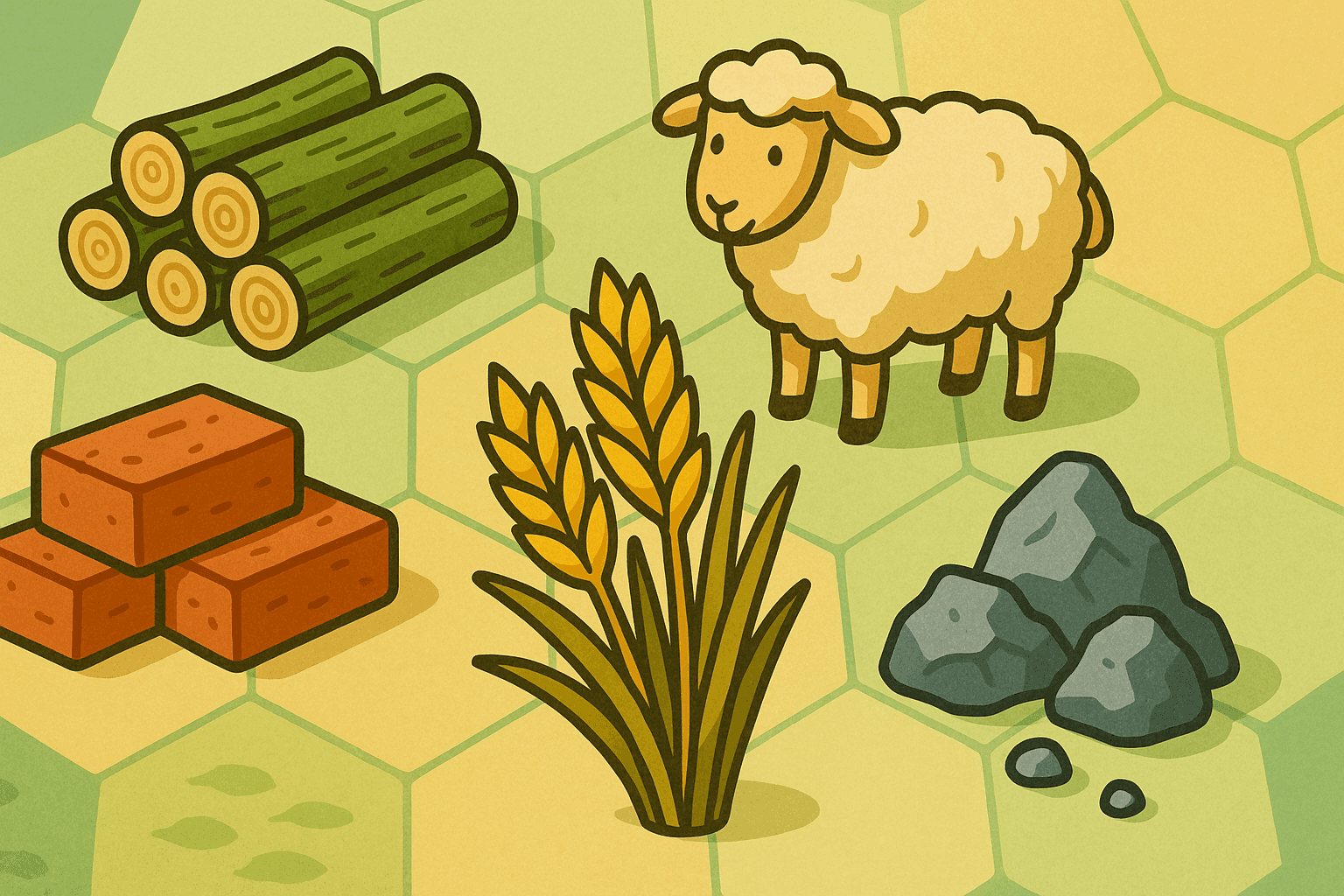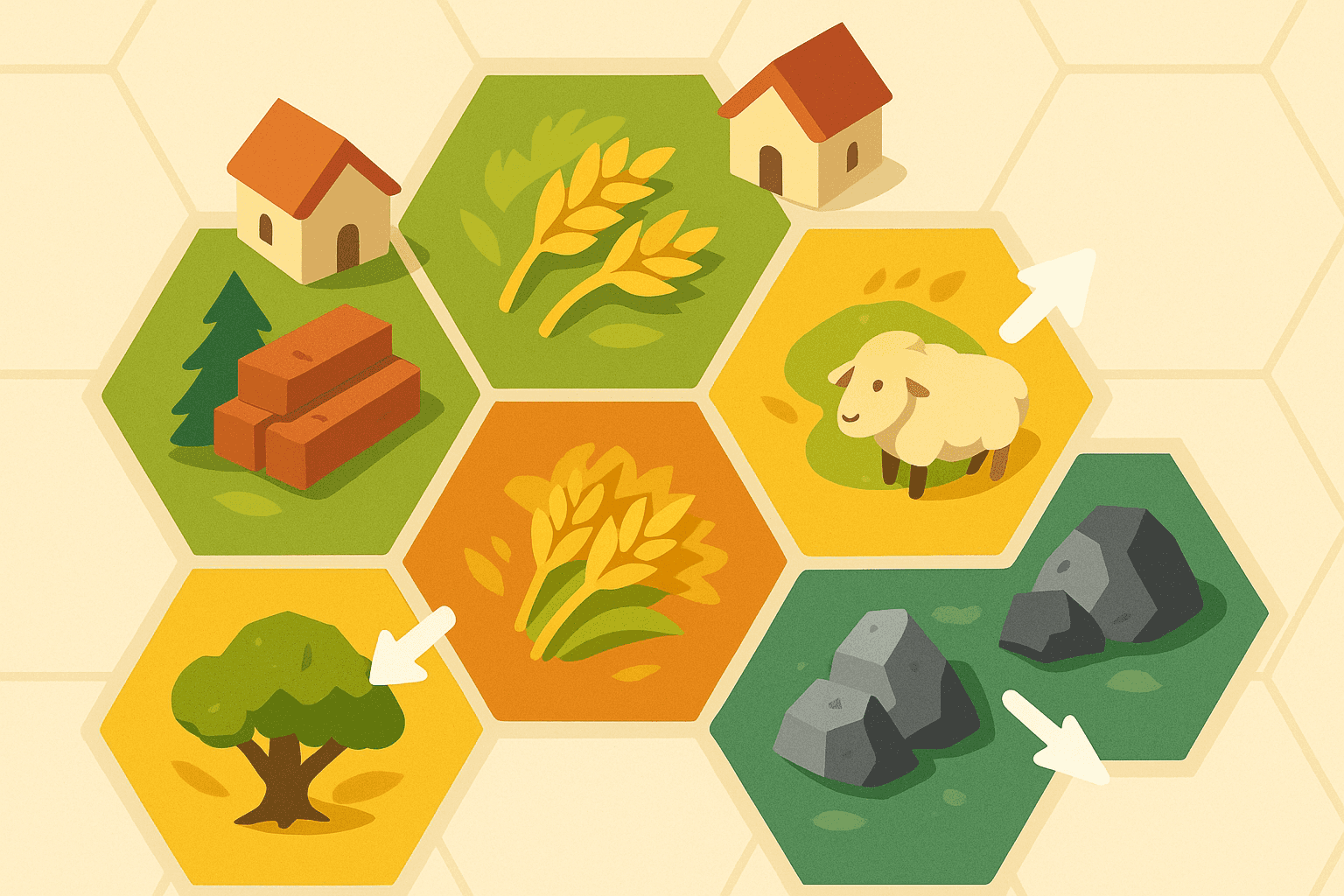
Understanding Catan Resources – What They Do and How to Use Them
In Catan, resources are everything. They power your roads, settlements, cities, and development cards - and managing them effectively can be the difference between winning and losing. While all five resources are important, their value changes depending on your strategy, board position, and opponents’ moves.
In this guide, we’ll break down the five main Catan resources - brick, wood, wheat, sheep, and ore - and explain how to use them strategically. If you’re new to the game, start by checking out our Catan game rules guide to understand the basics before diving into resource strategies.
Created By Adam Davis Fernsby
Overview of the Five Catan Resources
Catan revolves around collecting and managing five key resources:
- Brick
- Wood
- Wheat
- Sheep
- Ore
Each resource plays a unique role in the game: some are crucial early on, others dominate in the late game, and all of them influence your expansion, trading, and victory strategy.
Brick – Essential for Early Expansion
- Primary Uses: Building roads and settlements
- When to Prioritize: Brick is critical in the early game when you need to secure prime settlement spots
- Strategy Tip: If brick is scarce on the board, secure access early or plan trades to avoid getting blocked
Example: If you settle near 6-brick and 8-wood, you can quickly build roads to claim new spaces before opponents.
Wood – Roads, Settlements, and Flexibility
- Primary Uses: Works hand-in-hand with brick to build roads and settlements
- When to Prioritize: Early in the game, especially if you’re competing for the Longest Road
- Strategy Tip: Without wood, early growth slows down - aim to pair it with brick for efficient expansion
Example: On boards with limited wood spots, it can be worth sacrificing other resources to secure a high-pip wood tile.
Wheat – The Most Valuable Resource
- Primary Uses: Needed for settlements, cities, and development cards
- When to Prioritize: Always - wheat is the only resource used in every stage of the game
- Strategy Tip: High-probability wheat tiles are extremely valuable; missing wheat often stalls your entire strategy
Example: A strong start often includes at least one wheat-heavy tile combined with either ore for cities or brick/wood for expansion.
Sheep – Underrated but Important
- Primary Uses: Used in building settlements and buying development cards
- When to Prioritize: Best secured early if needed for settlements, but easier to trade later if overproduced
- Strategy Tip: If sheep is plentiful on the board, overproduce and trade extras for scarce resources like brick or wheat
Example: A player with access to two high-pip sheep tiles can leverage ports to dominate trading dynamics.
Ore – Powering Cities and Development Cards
- Primary Uses: Essential for city upgrades and development cards
- When to Prioritize: Critical mid-to-late game when transitioning from settlements to cities
- Strategy Tip: Combine high ore production with wheat for a powerful city-building strategy, especially when paired with knights from development cards
Example: Settling on 8-ore, 6-wheat, and 5-sheep sets up a strong “Ore-Wheat-Sheep” strategy, perfect for late-game dominance.
Catan Resource Comparison Table
| Resource | Used For | Early Game Value | Late Game Value | Trading Potential |
|---|---|---|---|---|
| Brick | Roads, settlements | High | Low | Medium |
| Wood | Roads, settlements | High | Low | Medium |
| Wheat | Settlements, cities, dev cards | High | Very High | High |
| Sheep | Settlements, dev cards | Medium | Low | Medium |
| Ore | Cities, dev cards | Low | Very High | High |
Tips for Managing Your Resources
- Balance production: Aim for at least three different resources between your starting settlements
- Watch scarcity: If one resource is rare on the board, secure it early or prepare to trade aggressively
- Use ports wisely: Ports make surplus resources more valuable - plan expansions accordingly
- Trade smartly: Only make trades that benefit you more than your opponent
- Plan ahead: Think about your mid- and late-game strategy when choosing starting spots
Example Scenario: Good vs Bad Resource Planning
Player A: Starts on 6-brick, 8-wood, 9-wheat
- Has balanced production
- Builds settlements quickly
- Uses trades to fill in missing resources
Player B: Starts on 3-sheep, 11-ore, 4-brick
- Lacks access to wheat and wood
- Gets blocked early and struggles to grow
- Forced into bad trades just to compete
Result: Player A dominates by producing consistently and expanding early, showing why smart resource planning matters.
Conclusion
Understanding and managing your resources in Catan is just as important as settlement placement and trading. Knowing when to prioritize brick and wood for early expansion, securing wheat for all phases of the game, and leveraging ore and sheep strategically will help you build faster, trade smarter, and win more often.
For a full overview of gameplay, rules, and mechanics, check out our Catan game rules guide before putting your resource strategy into action.


